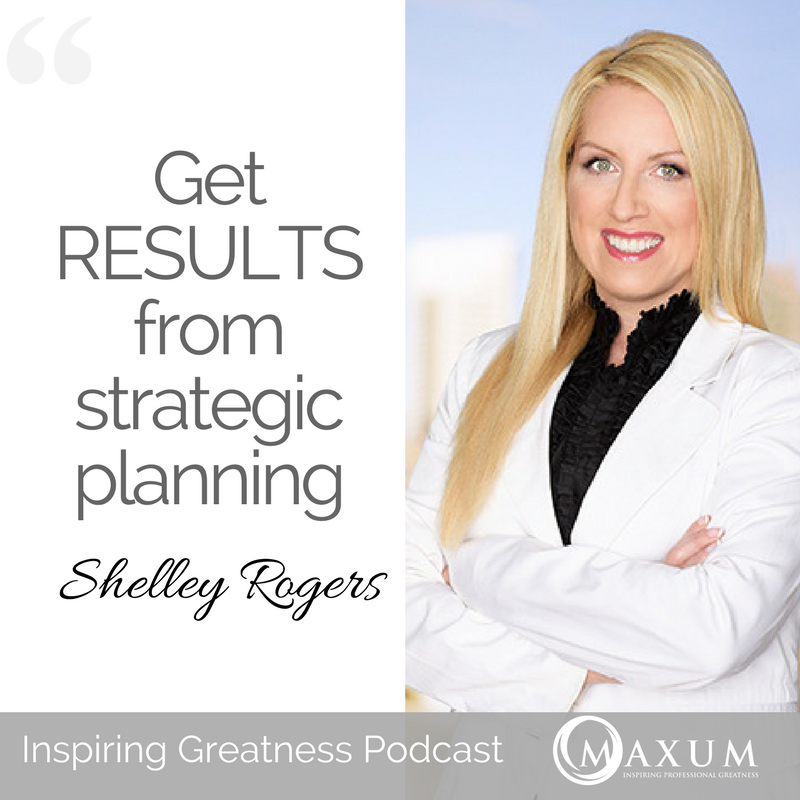- April 20, 2018
- Podcast
- Comments Off on 146 – Get Results from Strategic Planning

146 - Get Results from Strategic Planning
Last week we touched on how why annual planning sessions are important what’s the purpose, and the components or structure of a successful business retreat. This week we will focus on how to ensure the strategic planning gets implemented and your company see results. If you are going to spend the time and money bring all your top line managers or key executives to an annual 1 or 2 full day strategic planning retreat then you must make sure you will be getting the amazing results. I see it happen all the time: A group of managers get together at a resort for two days to hammer out a “strategic plan.” Done and dusted, they all head home. But have they produced a plan with a strategy? Do they have the correct plan and how are they going to execute is critical, otherwise it was just a waste of time and money.
Before we dive into the episode I want to take a minute to thank you for listening and if you enjoy this podcast please share and I would love if you could give us a rating and review while on iTunes hit the subscribe button so you never miss an episode

iTunes Link CLICK HERE

Stitcher link CLICK HERE
At the start of accelerator learning day I ask attendees, who are CEOs and small business owners, to write down an example of a strategy on a sheet of paper. They look at me quizzically at first as they realize that this is a tough assignment. I reassure them that this is indeed a hard question.
The responses were astonishing to me and them. Here are some of the responses from the list I received at my most recent session:
Actions (“launch a new product”; activities (“marketing our products through the right channels”);
Objectives (“achieve $1m net revenue”)
and broad descriptions of what goes on (“planning process from beginning to end of a new service”; “working for your stakeholders”).
Sorry, but these responses are not a strategy.
Unfortunately, while CEO’s talk “strategy,” they’re often confused about what it means. Why this confusion? The problem starts with the word itself — a misunderstood concept in management and board circles. The most basic mix-up is between “objective,” “strategy,” and “action.” (I see this frequently in published strategic plans as well.) Grasp this, and your day will be well spent.
Let’s start with what is an objective? It is s something you’re trying to achieve — a indicator of the success of the organization. At the other end of the spectrum is “action.” This occurs at the individual level — a level that managers are presented with day after day. So naturally when they think “strategy” they focus on what they do. But this isn’t strategy either. So, what is Strategy? Strategy takes place between these two at the organization level and managers can’t “feel” that in the same way. It’s abstract. CEOs have an advantage here because only they have a total view of the organization.
The key to strategy is that it’s the positioning of one business against others — Uber against taxi industry, for example. What exactly is positioning? It’s placement on the strategic factors relevant to each key stakeholder group.
A company or orgnaization exists as part of a system composed of transactions between itself and its key stakeholders such as customers, employees, suppliers and shareholders. Organizations differ in the detail of these sets, of course, depending on the complexity of the industry in which they’re located.
The task of a strategic planning team is to produce positions on these factors that deliver value to the organization’s key stakeholders and meet the objectives of the organization. Let’s go back to the response examples I mentioned earlier: “achieve $1m net revenue.” This is an objective, rather than a strategy. A strategy serves an objective by providing a position on the relevant strategic factors — in this case for customers.
Let’s say the strategic planning team identifies “price” as one strategic factor. In this case let’s make the business Dan Murphy’s, Australia’s largest liquor retailer with a national footprint. It has stated its position on this factor clearly: “Lowest liquor price guaranteed. In the unlikely event that a customer finds a lower price, we’ll beat it on the spot.” This is that company’s position on price.
Now to ensure implementation, a strategic planning team must identify some project- or program-level actions. McDonalds had to do this when on “product range” it took this position: Traditional meal range but with an increased emphasis on salad items and with the option for customers to design their own burgers. Periodic special offerings to spur customer interest. You can envision the high-level actions that might follow such as: Design a training program for all staff in made-to-order food handling procedures.
If you take a helicopter view of the process outlined, you can see that it involves system design. Each key stakeholder group is taken in turn to work out what an organization wants from it (an objective) and what the key stakeholder wants from it (strategic factors) e.g. customers want effective performance on factors such as price and customer service. The strategic planning team must then decide on the organization’s position on these factors (strategy). This will be conditioned, of course, by customer research. Having done this, key stakeholder by key stakeholder, the next step is to ensure congruence — a fit between employee relations and customer relations, customer relations and supplier relations, and so on — system design.
My experience in working with clients over many years is that executive teams fail to approach strategic planning from a system-design perspective. A major cause of this is that managers within these teams approach the task from their own functional-management view, e.g. finance, HR, marketing, operations. Consequently, they think “action” when they mean to think “strategy.” Taking a stakeholder approach to strategic planning induces managers to raise their thinking to the organization level.
Remember. Strategic planning is a journey, not a project. It takes time and needs to be reviewed. Yes, kick start yours with a two-day retreat. But never end it there. A strategic plan is not a set-and-forget instrument. It’s a living and breathing document that guides decision making and helps marshal resources. When managers talk about “giving up on strategic planning” I suggest that they haven’t thought through how to keep their plan fresh. The fact that circumstances are changing rapidly is a very good reason to visit their plan regularly. How regularly? This varies by industry, of course, but my general recommendation to is monthly. So put aside the first meeting of each month for a plan review. This allows you to not only update the document due to changed conditions but to also go through the actions that were scheduled for completion as part of the execution process. Make your agenda item “progress against strategic plan.” Refer to episode 144 on specific agenda for monthly management meetings.
In summary, Successful Strategic planning retreats require 3 very important components.
- Pre-planning is a must! Gathering employee and customer feedback and ensuring you have THOROUGH FINANCIAL ANALYSIS of your business you can get more information on episode 145 - How to plan your company annual strategy retreat.
- Hire a professional facilitator to lead your company thru the agenda. Ensuring they need to focus on the organization and key stakeholders, not individual actions. A plan can’t be “strategic” if it’s simply about action by individuals. While action is fundamental to implementation and success, there’s another level above that — the organization level. In my experience most managers, operating as they do inside their organization, aren’t fully aware of this important distinction. This can have them launching prematurely into who, what and when. Business strategy operates at the corporate level while action functions at the individual level.
- A strategic plan is not a set-and-forget instrument. It’s a living and breathing document that guides decision making and helps marshal resources. Have key executives sign the plan to ensure they have buy in and understand what they will be held accountable for. Review at least once a month at the management meeting and tweak or change quickly to adapt any changes in you market conditions or competition.
I hope you enjoyed this episode. If you have any questions on how to plan and have a successful annual strategy retreat please don’t hesitate to reach out. As I love facilitating them and currently pleased to offer corporate retreat programs through my business Maxum corporation. We have a to special offer for my inspiring greatness listeners. Book your corporate retreat using code MAXretreat and receive $500 discount off a one day program and a $750 discount off a two day program. All you need to do to get more information on this offer tap on the corporate retreat link in the description of this episode or email Shelley@maxumcorp.com.au
I would like to end with a quote.
Strategy without tactics is the slowest route to victory, tactics without strategy is the noise before defeat.” —Sun Tsu, Ancient Chinese Military strategist
“In order to understand the world, one has to turn away from it on occasion."
[The Minotaur]”
― Albert Camus,







0 Comment